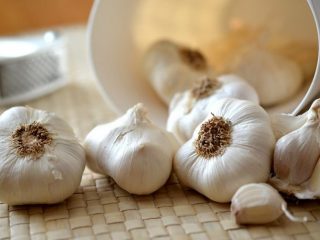Content
In Russia, garlic is grown everywhere. And although planting and caring for the crop does not cause difficulties, not many manage to preserve the vegetable until winter. Therefore, gardeners are looking for various ways to increase storage time. The need to wash garlic after harvesting has a direct impact on timing.
Is it possible to wash garlic before storing?
After harvesting, garlic is usually cleared of the soil by hand and immediately stored. Washing vegetables, especially spring varieties, is prohibited. It is also advisable not to wet winter garlic unless necessary. Saturation of the head with moisture has a bad effect on the duration of storage.
However, there are methods for storing vegetables that involve wet cleaning. It should be washed when the onion is stored in slices.

The peeled crop lasts longer, and after drying, the owner can discard the over-moistened material
Washing the plant after harvesting is allowed when the slices are needed in their purified form. To preserve them, they are filled with oil. When stored in this way, the product is processed, and it is impossible not to rinse and dry it before use.
Spring and winter varieties are recommended to be stored with heads that are not completely cleared of soil. After drying, the soil will fall off on its own, and from it you can judge the completion of the process.
If the cleaning took place on a clear summer day, there is no need for wet cleaning. It is enough to brush off the soil with gloves. Moisture, on the contrary, only “sticks” more dirt to the garlic. The less the onion is washed, the longer it will last.
Why you shouldn't wash garlic after harvesting
Botanists warn: garlic is hygroscopic. This means that the vegetable easily absorbs liquid. Garlic should not be washed after harvesting, because this can lead to its sprouting, and all the beneficial vitamins contained in the fruit will go into the stems.
Another problem with overwatering is rotting. If you store a wet product, soon only small areas of the crop will remain that are not covered with mold.
Whether it is correct to wash garlic after digging or not depends on whether you plan to use it in the near future. If yes, the product must be washed.

In other cases, the heads are not pre-treated after harvesting in order to increase storage time
Drying wet garlic
If you wash the product after cleaning, you need to dry it quickly. To do this, use an electric dryer, which completely dries the vegetable, preventing mold from appearing. By following natural methods (drying under a canopy on the street or at home on a window), the owner runs the risk of causing the heads to rot, although the risk, it must be said, is minimal.
When crops are exposed to rain or harvesting is carried out in wet weather, action must be taken quickly. Of course, the best solution would be to leave the garlic in the garden for another day. But if this is not possible, dry it yourself.
The drying period for garlic is about a week. A wet product takes twice as long. The crop that gets wet in the rain is dried for an additional 15-20 days. If there is no electric dryer, after harvesting the plant is immediately transferred indoors.

When the sun's rays appear, the garlic can be moved outside, under a canopy.
How to make garlic look marketable
To give the product a beautiful appearance, it must be cleaned. It is not necessary to wash the garlic, but it is allowed. In this case, do not forget about the rules:
- There is no need to keep the vegetable under running water - the less moisture the heads receive, the better.
- If there is dirt on the bulb, it should first be removed with a brush and only then rinsed under the tap. This sequence is justified by the fact that the owner will spend less time trying to remove a lump of dirt with a stream of water. Consequently, the garlic will receive less moisture.
- When mechanically cleaning, try not to overdo it with pressure. The presence of scratches indicates that the garlic will not last long after harvesting.
- After washing, the raw materials are placed separately from each other for drying. Try not to dry wet garlic in direct sunlight. Ultraviolet radiation destroys the beneficial substances contained inside the plant, and it loses its original value.
- Dried crops must be sprinkled with absorbent substances before storage. They will absorb excess moisture. These substances include salt, garlic and onion peels. Foliage and straw perform a little worse.
Instead of washing garlic after harvesting, it is better to consider other cleaning methods:
- Bulkhead. The bulbs themselves are cleaned of dirt during culling, simply by rubbing the heads against each other.
- Wiping. You can remove dirt with your hands by picking up the fruit and making light circular movements. The main thing is not to exert excessive force.
- Shake. After drying, the raw materials are placed on a sieve and shaken. The soil will fall off the bulbs, but the material itself will not be damaged in any way.

Storing bulbs is no different from storing other vegetables.
No special rules are required for this, but there is no need to neglect inspection either: high humidity reduces storage time. Therefore, the product should be washed only in extreme cases or before direct use.
Conclusion
Whether or not to wash garlic after harvesting is, of course, up to everyone to decide. But you should remember the dangers that overwatering entails. A hygroscopic vegetable absorbs moisture very quickly, and therefore can become moldy and rot. Experts advise using other cleaning methods.








